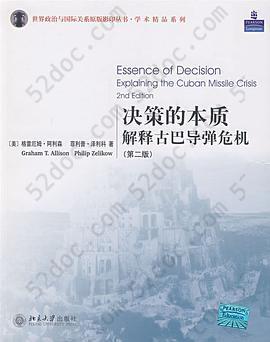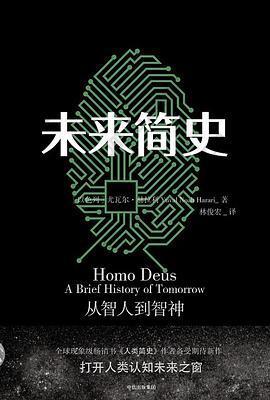注重体验与质量的电子书资源下载网站
分类于: 其它 互联网
简介

决策的本质: 解释古巴导弹危机 豆 9.2分
资源最后更新于 2020-10-23 14:31:36
作者:[美]格雷厄·阿利
出版社:北京大学出版社
出版日期:2008-01
ISBN:9787301132364
文件格式: pdf
标签: 决策 政治 国际关系 政治学 古巴导弹危机 历史 政策研究 冷战
简介· · · · · ·
这是第二次世界大战后最有影响力的政治学著作之一。《决策的本质》原作以独特的视角审视了冷战时期的关键事件。此经典著作的第二版不仅仅是修订,更是重写:重新解释了古巴导弹危机前后的理论及事件;也融入了肯尼迪录音带及最近解密的苏联文件的信息。第二版提炼了原著中格雷厄姆·阿利森任美国助理国防部长及哈佛大学肯尼迪政府学院院长时期的一些评论和观点。同时也有一位新的作者菲利普·泽利科参与了第二版的撰写,他著有十分畅销的评论著作《肯尼迪录音带》(The Kennedy Tapes,Harvard University Press,1 997)。 《决策的本质》(第二版)鲜活地展现了重压之下的决策过程,此书也是唯一一部尝试解决这一经久不衰的问题的著作:人们如何理解政府的举动?
目录
Preface
Introduction
1 Model I: The Rational Actor
A Rigorous Model of Action
A Rational Actor Paradigm
The Classical Model Illustrated
Classical Realism. Neorealism (Structural Realism).
International Institutionalism. Liberalism. Strategy, War,
and Rational Choice.
Variants and Uses of the Classical Model
2 The Cuban Missile Crisis: A First Cut
Why Did the Soviet Union Decide to Place Offensive Missiles in
Cuba?
Hypothesis 1: Cuban Defense. Hypothesis 2: Cold War Politics.
Hypothesis 3: Missile Power. Hypothesis 4: Berlin——Win,
Trade, or Trap.
Why Did the United States Respond to the Missile Deployment
with a Blockade?
Alternative I: Do Nothing. Alternative 2: Diplomatic
Pressures. Alternative 3: A Secret Approach to Castro.
Alternative 4: Invasion. Alternative 5: Air Strike.
Alternative 6: Blockade.
Why Did the Soviet Union Withdraw the Missiles?
3 Model II: Organizational Behavior
Organizational Logic and Efficiency
Organizational Logic and Organizational Culture
Interactive Complexity
NASA: Hero and Goat
Organizational Behavior Paradigm
4 The Cuban Missile Crisis: A Second Cut
Deployment of Soviet Missiles in Cuba
The Soviet Build-up in Detail. Organizational
Implementation.
Imposition of a U.S. Blockade of Cuba
Organizational Intelligence. Organizational Options.
Organizational Implementation.
The Withdrawal of Soviet Missiles from Cuba
5 Model III: Governmental Politics
The Governmental Politics Model Illustrated __
1. Separated Institutions Sharing Power. 2. The Power to
Persuade. 3. Bargaining According to the Processes. 4. Power
Equals Impact on Outcome. 5. Intranational and
International Relations.
Group Processes and Their Effects on Choices and Action
1. Better Decisions. 2. The "Agency" Problem: Principals,
Agents, and Players. 3. Participants: Who Plays? 4. Decision
Rules. 5. Framing Issues and Setting Agendas. 6. Groupthink.
7. Complexity of ]oint Action.
A Governmental Politics Paradigm
6 The Cuban Missile Crisis: A Third Cut
The Imposition of a Blockade by the United States
The Politics of Discovery. The Politics of Choice.
Soviet Withdrawal of the Missiles from Cuba
Soviets Kill an American U-2 Pilot. The President and the
Chairman. The "Deal": Resolving the Turkish Problem.
The "Deal": Resolving the Cuban Problem.
7 Conclusion
Summing Up: Differences in Interpretation
Summing Up: Different Answers or Different Questions?
Where Do We Go from Here?
Index
Introduction
1 Model I: The Rational Actor
A Rigorous Model of Action
A Rational Actor Paradigm
The Classical Model Illustrated
Classical Realism. Neorealism (Structural Realism).
International Institutionalism. Liberalism. Strategy, War,
and Rational Choice.
Variants and Uses of the Classical Model
2 The Cuban Missile Crisis: A First Cut
Why Did the Soviet Union Decide to Place Offensive Missiles in
Cuba?
Hypothesis 1: Cuban Defense. Hypothesis 2: Cold War Politics.
Hypothesis 3: Missile Power. Hypothesis 4: Berlin——Win,
Trade, or Trap.
Why Did the United States Respond to the Missile Deployment
with a Blockade?
Alternative I: Do Nothing. Alternative 2: Diplomatic
Pressures. Alternative 3: A Secret Approach to Castro.
Alternative 4: Invasion. Alternative 5: Air Strike.
Alternative 6: Blockade.
Why Did the Soviet Union Withdraw the Missiles?
3 Model II: Organizational Behavior
Organizational Logic and Efficiency
Organizational Logic and Organizational Culture
Interactive Complexity
NASA: Hero and Goat
Organizational Behavior Paradigm
4 The Cuban Missile Crisis: A Second Cut
Deployment of Soviet Missiles in Cuba
The Soviet Build-up in Detail. Organizational
Implementation.
Imposition of a U.S. Blockade of Cuba
Organizational Intelligence. Organizational Options.
Organizational Implementation.
The Withdrawal of Soviet Missiles from Cuba
5 Model III: Governmental Politics
The Governmental Politics Model Illustrated __
1. Separated Institutions Sharing Power. 2. The Power to
Persuade. 3. Bargaining According to the Processes. 4. Power
Equals Impact on Outcome. 5. Intranational and
International Relations.
Group Processes and Their Effects on Choices and Action
1. Better Decisions. 2. The "Agency" Problem: Principals,
Agents, and Players. 3. Participants: Who Plays? 4. Decision
Rules. 5. Framing Issues and Setting Agendas. 6. Groupthink.
7. Complexity of ]oint Action.
A Governmental Politics Paradigm
6 The Cuban Missile Crisis: A Third Cut
The Imposition of a Blockade by the United States
The Politics of Discovery. The Politics of Choice.
Soviet Withdrawal of the Missiles from Cuba
Soviets Kill an American U-2 Pilot. The President and the
Chairman. The "Deal": Resolving the Turkish Problem.
The "Deal": Resolving the Cuban Problem.
7 Conclusion
Summing Up: Differences in Interpretation
Summing Up: Different Answers or Different Questions?
Where Do We Go from Here?
Index








